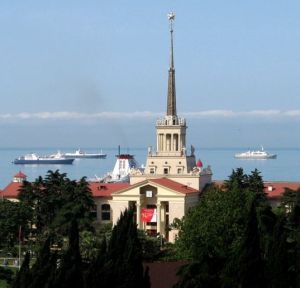Sochi: the Host City

The port city and subtropical resort was established in 1902
 Sochi Seaport Related Links |
The city of Sochi lies on the east coast of the Black Sea, nestled between the mountains and the sea. Considered the pearl of the “Russian Riviera,“ Sochi is a resort town in need of a facelift, and hosting the Games provides a perfect opportunity for such renovations. Even with the highest price tag of any Olympics (and actually exceeding the combined cost of all previous Winter Games), the improvements have been somewhat haphazard. Sochi's sanitariums, which once housed recuperating workers under Stalin, are a perfect example. While some have been repurposed as boutique hotels, others are left to decay, their neoclassical forms a stark contrast to the shiny new construction.
President Vladimir Putin fought hard to win the Olympics for Sochi, dramatically outbidding the two other finalists. The Russian Federation beat out Salzburg, Austria, and Pyeongchang, South Korea, for the honor of host city. As a result, the population of Sochi is expected to increase from 400,000 (comparable to Oakland, Calif.) to 4.4 million during the Games.
Transformation for the Games
The key word for these Olympics is accessibility, both small- and large-scale. Because the venues will be used for both the Olympics and the Paralympics, they were constructed with consciousness of access and are being touted as “barrier free.“ Visitors and athletes alike should find it easy to navigate both within and between the individual venues. The 11 athletic venues are divided between a mountain and a coastal cluster, with travel time between the two promised to be 30 minutes via brand-new railway—the shortest commute of any Games. Within each cluster, travel time to venues shouldn't exceed 15 minutes.
Coastal Cluster
The narrow flatland that is the Imeretinskaya Valley is the setting for the Sochi Olympic Park, which houses all the ice venues—within walking distance of each other—including the Bolshoi Ice Palace, the Maly Ice Palace, the Olympic Oval, the Sochi Olympic Skating Center, and the Olympic Curling Center. The main Olympic Village forms the connecting hub of these venues and makes for a convenient five minute commute time. The capacity of the Olympic Park is 70,000 visitors.
Mountain Cluster
The Krasnaya Polyana mountains will be home to the skiing and sliding sports and include Biathlon and Ski Complexes, a Bobsleigh Track, a Ski Center, a Ski Jump Complex, and a Snowboard Park, and Freestyle Center. Another Olympic Village will be the starting point for navigating the mountain cluster, with a projected travel time of less than 15 minutes to each competition venue.
They Built It and They Will Come
At the heftiest price tag yet, Sochi's $50 billion Olympic facelift should provide a stunning backdrop to the world's favorite sporting event. But the one thing that organizer's can't control is the weather. That's not to say they aren't trying. Remember, Sochi is the Russian Federation's summer playground. With last year's winter temperatures in the 60s, there is precedent for concern. Organizers have stockpiled 16 million cubic feet of snow under thermal blankets, installed state-of-the-art snowmaking machines, have on hand specialized snow salt used to delay melting, and set up snow gutters to transport snow from the upper elevations just in case Jack Frost decides to boycott these Olympics.
—Catherine McNiff








